GENERAL ELECTRIC PCG23 User Manual [fr]

Refrigerators
Side-by-Side
ge.com
Safety Instructions . . . . . . . . . . . . . . . . .2–3
Operating Instructions
Automatic Icemaker . . . . . . . . . . . . . . . . . . . .10
Care and Cleaning . . . . . . . . . . . . . . . . . . .12, 13
Crispers and Pans . . . . . . . . . . . . . . . . . . . . . . . .9
Ice and Water Dispenser . . . . . . . . . . . .11, 12
Refrigerator Doors . . . . . . . . . . . . . . . . . . . . . . .8
Replacing the Light Bulbs . . . . . . . . . . . . . . .14
Shelves and Bins . . . . . . . . . . . . . . . . . . . . . . .6, 7
Temperature Controls . . . . . . . . . . . . . . . . . . . .4
TurboCool™ . . . . . . . . . . . . . . . . . . . . . . . . . . . . . .4
Water Filter . . . . . . . . . . . . . . . . . . . . . . . . . . . . . .5
Installation Instructions
Installing the Refrigerator . . . . . . . . . . . .20–23 Moving the Refrigerator . . . . . . . . . . . . .16–19 Preparing to Install
the Refrigerator . . . . . . . . . . . . . . . . . . . . . . . . .15 Water Line Installation . . . . . . . . . . . . . .24–26
Troubleshooting Tips . . . . . . . . . . . .27–30
Normal Operating Sounds . . . . . . . . . . . . . . .27
Consumer Support
Consumer Support . . . . . . . . . . . . .Back Cover
Performance Data Sheet . . . . . . . . . . . . . . . .31
State of California Water
Treatment Device Certificate . . . . . . . . . . . .33
Warranty (Canadian) . . . . . . . . . . . . . . . . . . . .34
Warranty (U.S.) . . . . . . . . . . . . . . . . . . . . . . . . .35
Write the model and serial numbers here:
Model # __________________________
Serial # __________________________
Find these numbers on a label inside the refrigerator compartment at the top on the right side.
Owner’s Manual
and Installation
Models 22, 23, 25, 26 and 27
Côte à Côte
Réfrigérateurs
Manuel d’utilisation
et d’installation
La section française commence à la page 36
Lado a Lado
Refrigeradores
Manual del propietario
e instalación
La sección en español empieza en la página 70
200D8074P025 49-60578 11-08 JR

Operating Instructions Safety Instructions
Installation |
Instructions |
Consumer Support Troubleshooting Tips
IMPORTANT SAFETY INFORMATION.
READ ALL INSTRUCTIONS BEFORE USING.
 WARNING!
WARNING!
Use this appliance only for its intended purpose as described in this Owner’s Manual.
SAFETY PRECAUTIONS
When usingelectrical appliances, basicsafety precautions should be followed, including the following:
■This refrigerator must be properlyinstalled and located in accordance withthe Installation Instructions before it is used.
■Do not allow childrento climb,stand or hang on the shelves in the refrigerator.They could damage the refrigerator and seriously injure themselves.
■Do not touch the cold surfaces in the freezer compartment when hands are damp or wet. Skin may stick to these extremely cold surfaces.
■Do not store or use gasoline or otherflammable vapors and liquids in the vicinityof this or any other appliance.
■In refrigerators with automatic icemakers, avoid contact withthe moving partsof the ejector mechanism,or with the heating element locatedon the bottom of the icemaker.Do
not place fingers or handson the automatic icemaking mechanismwhile the refrigerator is plugged in.
■Keep fingers out of the “pinch point” areas; clearances between the doors and between the doors and cabinet are necessarily small. Be careful closing doors when children are in the area.
■Unplug the refrigerator beforecleaning and making repairs.
NOTE: We strongly recommend that any servicing be performed by a qualified individual.
■Do not refreeze frozen foods which have thawed completely.
NOTE: Turning the refrigerator off via the controlson the touch panel does not shut off electrical power to the refrigerator.
2
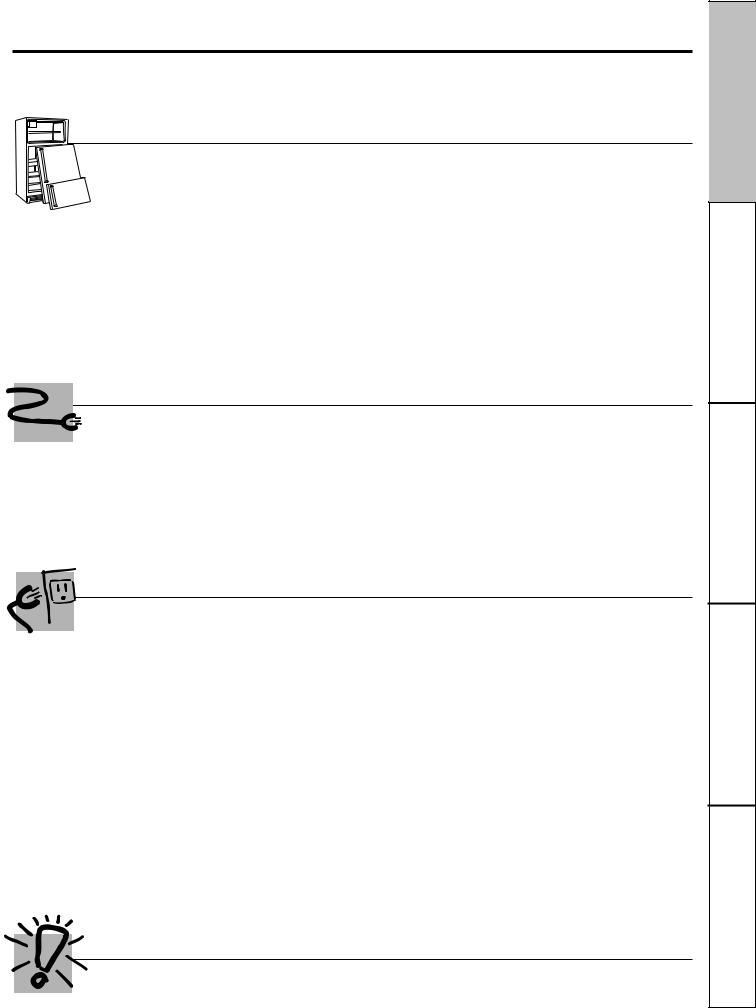
ge.com
 DANGER! RISK OF CHILD ENTRAPMENT
DANGER! RISK OF CHILD ENTRAPMENT
PROPERDISPOSAL OF THE REFRIGERATOR
Childentrapment and suffocation are not problems |
Refrigerants |
|
of the past. Junked or abandoned refrigerators are |
All refrigeration products contain refrigerants, which |
|
still dangerous…even if they willsit for “just a few |
||
under federal law must be removed prior to product |
||
days.” If you are getting rid of your old refrigerator, |
||
disposal. If you are getting rid of an old refrigeration |
||
please follow the instructions below to help prevent |
||
product, check with the company handling the |
||
accidents. |
||
disposal about what to do. |
||
BeforeYou ThrowAway Your Old |
||
|
||
Refrigerator or Freezer: |
|
■Take off the doors.
■Leave the shelvesin placeso that childrenmay not easilyclimbinside.
USE OF EXTENSION CORDS
Because of potential safety hazards undercertain conditions, we strongly recommend againstthe use of an extension cord.
However, if you must use an extension cord, it is absolutely necessary that it be a UL-listed (in the United States) or a CSA-listed (in Canada),3-wire groundingtype appliance extension cordhaving a grounding type plugand outlet and that the electrical rating of the cord be 15 amperes (minimum)and 120 volts.
 WARNING!
WARNING!
HOW TO CONNECT ELECTRICITY
Do not, under any circumstances, cut or remove the third (ground) prong fromthe powercord. For personal safety, this appliance must be properly grounded.
The power cord of this appliance is equipped witha 3-prong (grounding) plug which mates witha standard3-prong (grounding)walloutlet to minimizethe possibility of electric shock hazard fromthis appliance.
Havethe walloutlet and circuit checked by a qualified electrician to makesure the outlet is properly grounded.
If the outletis a standard2-prong outlet, it is yourpersonal responsibilityand obligationto haveit replaced with a properly grounded 3-prong walloutlet.
The refrigeratorshould always be pluggedinto its own individual electricaloutlet whichhas a voltage ratingthat matches the rating plate.
This provides the best performance and also prevents overloading house wiring circuits which could cause a fire hazard from overheated wires.
Never unplug yourrefrigerator by pulling on the power cord. Always grip plug firmly and pull straight out from the outlet.
Repair or replace immediately all power cords that have become frayed or otherwise damaged. Do not use a cordthat shows cracks or abrasion damage along its length or at either end.
When moving the refrigerator away from the wall, be careful not to roll over or damage the power cord.
READ AND FOLLOWTHIS SAFETY INFORMATION CAREFULLY.
SAVE THESE INSTRUCTIONS
3
Instructions Operating Instructions Safety
Instructions |
Installation |
Support Consumer Tips Troubleshooting

Operating Instructions Safety Instructions
Installation |
Instructions |
Consumer Support Troubleshooting Tips
About the temperaturecontrols.
Not all features are on all models.
The temperature controlsare presetin the factoryat 37°F for the refrigeratorcompartment and 0°F for the freezercompartment. Allow 24 hours for the temperatureto stabilizeto the presetrecommendedsettings.
The temperature controlscan displayboththe SET temperatureas wellas the actual temperaturein the refrigerator and freezer.The actualtemperaturemay vary slightlyfrom the SET temperature basedon usage and operating environment.
■ On some models, settingbothcontrols to the warmestsettinguntilthe display flashes (off) willstop cooling in both the freezerand refrigeratorcompartments.
■ On other models, setting either control to the warmestsettinguntilthe display flashes(off) willstop the coolingto the freezer and refrigerator.
■ NOTE: Turningthe refrigeratoroff via the controlson the touchpaneldoesnot shut off electricalpower to the refrigerator.
NOTE: The refrigerator is shipped withprotectivefilm coveringthe temperature controls. If thisfilm was not removed during installation,removeit now.
Performance Air Flow System
The PerformanceAir-Flow Systemis designedto |
will not affectperformance.Although the Air Tower |
maximize temperaturecontrolin the refrigerator |
and the Air Tunnelcan be removed,doingso will |
and freezer compartments.This uniquespecial |
affecttemperatureperformance.(For removal |
featureconsistsof the Air Tower alongthe back |
instructions,on-line,contactus at ge.comor |
wall of the refrigeratorand the Air Tunnelon the |
call800.GE.CARES. In Canada,contactus at |
bottom portion of the freezerrearwall. Placing |
geappliancesca. or call 1.800.561.3344.) |
foodin front of the louvers on thesecomponents |
|
About TurboCool.™ (on some models)
How it Works
TurboCool rapidly cools the refrigerator compartmentin order to morequicklycoolfoods. Use TurboCool whenaddinga largeamount
of foodto the refrigerator compartment,putting awayfoodsafterthey have beensittingout at room temperature or whenputtingawaywarm leftovers. It can alsobe usedif the refrigerator has beenwithoutpowerfor an extendedperiod.
Onceactivated, the compressorwillturnon immediatelyand the fanswillcycleon and off at highspeedas needed for eighthours. The compressorwill continueto run untilthe
refrigerator compartmentcools to approximately 34°F (1°C), then it will cycleon and off to maintain this setting.After8 hours,or if TurboCoolis pressedagain, the refrigeratorcompartment
will return to the originalsetting.
4
How to Use
PressTurboCool. The TurboCool temperature displaywillshowTc and the LED willbe activated.
AfterTurboCool is complete,the TurboCool indicator light will go out.
NOTES: The refrigerator temperature cannotbe changedduringTurboCool.
The freezertemperatureis not affected during TurboCool.
Whenopeningthe refrigeratordoor during TurboCool, the fanswillcontinue to run if theyhavecycledon.

About the water filter. (on some models) |
ge.com |
Water Filter Cartridge
The waterfilter cartridgeis located in the backupper right corner of the refrigerator compartment.
When to Replacethe Filter on Models With a Replacement Indicator Light
There is a replacementindicatorlightfor the waterfilter cartridgeon the dispenser.Thislight willturnorangeto tell you thatyou need to replacethe filter soon.
The filter cartridge shouldbe replacedwhen the replacement indicator lightturnsred or if the flow of waterto the dispenser or icemakerdecreases.
When to Replacethe Filter on Models Without a Replacement Indicator Light
The filter cartridge shouldbe replacedevery six months or earlier if the flowof waterto the water dispenser or icemaker decreases.
Removingthe FilterCartridge
If you are replacingthe cartridge, firstremovethe old one by slowlyturningit to the left. Do not pull down on the cartridge. A small amountof watermay drip down.
Installingthe FilterCartridge
If you are replacing a SmartWater cartridgewith an adapter,it must be removed before installingthe
cartridge. To remove the adapter,turn it to the leftabout 1/4 turn.
If you are replacing a Waterby Culligan cartridge, leave the adapter in place.This adapter willstay in the refrigeratorwhenyou replacefuture cartridges.
With adapter |
|
Without adapter |
|
||
|
(appearance may vary)
On models withouta replacement indicatorlight, apply the monthand year stickerto the new cartridgeto remind you to replacethe filter in six months.
Fill the replacement cartridge with water fromthe tap to allow for better flow from the dispenser immediatelyafter installation.
Lineup the arrow on the cartridge and the cartridge holder.Place the top of the new cartridge up inside the holder.Do not push it up into the holder.
 Slowly turn it to the right until the filter cartridge stops. DO NOT OVERTIGHTEN. As you turn the cartridge, it will automatically raise itself into position. The cartridge will move about 1/2 turn.
Slowly turn it to the right until the filter cartridge stops. DO NOT OVERTIGHTEN. As you turn the cartridge, it will automatically raise itself into position. The cartridge will move about 1/2 turn.
CartridgeHolder
Run water from the dispenser for 3 minutes (about 1-1/2 gallons) to clear the system and prevent sputtering.
Press and hold the WATER FILTER pad (on some models) on the dispenser for 3 seconds.
NOTE: A newly-installed water filter cartridge may cause water to spurt from the dispenser.
Filter Bypass Plug
You must use the filter bypass plug when a replacementfilter cartridge is not available. The dispenser and the icemakerwill not operate without the filter or filter bypass plug.
|
Filter |
Filter |
Bypass |
Plug |
|
Bypass |
|
Plug |
|
SmartWater |
Waterby Culligan |
To use the filter bypass plug on Water by Culligan models,you must first remove the filter adapter from the cartridge holder by turning it to the left.
If you have questions—visit our Website at ge.com, or call 1.800.GE.CARES (1.800.432.2737).
Replacement filters:
To order additional filter cartridges in the United States, visit our Website at ge.com, or call GE Parts and Accessories, 800.626.2002.
MSWF
Suggested Retail $36.95–41.95
Customers in Canada should consult the yellow pages for the nearest Mabe Service Center.
5
Instructions Operating Instructions Safety
Instructions |
Installation |
Support Consumer Tips Troubleshooting

Operating Instructions Safety Instructions
Installation |
Instructions |
Consumer Support Troubleshooting Tips
About the shelves and bins.
Not all features are on all models.
Snugger
Refrigerator bin
Freezer bin
Refrigerator Door Bins and Freezer Door Tilt-Out Bins
LargeBins
The larger refrigerator door binsand freezer tilt-out door bins are adjustable.
To remove: Lift the front of the bin straight up, then lift up and out.
To replace or relocate: Engagethe back side of the bin in the moldedsupports of the door. Then push down on the front of the bin. Bin willlock in place.
Small Bins
To remove: Lift the front of the bin straight up then out.
To replace: Position the bin above the rectangular molded supportson the door. Then slidethe bin down onto the support to lock it in place.
The snugger helps prevent tipping, spilling or sliding of small items stored on the door shelf. Place a finger on either side of the snugger near the rear and move it back and forth to fit your needs.
Do not block
CAUTION:
On models with an ice chute inside the top freezer door bin, be careful when placing items in the bin. Make sure that items do not block or fall into the ice chute.
Freezer tilt-out bin
Press tab and pull shelf forward to remove
Slide-Out Spillproof Shelf
The slide-out spillproof shelf allows you to reach items stored behind others. The
special edges are designed to help prevent spillsfrom dripping to lowershelves.
To remove:
Slidethe shelf out untilit reaches the stop, then press down on the tab and slide the shelf straight out.
To replace or relocate:
Line the shelf up with the supports and slide it into place. The shelfcan be repositioned when the door is at 90° or more. To reposition the shelf, slidethe shelf pastthe stops and angle downward. Slide shelf down to the desired position, lineup withthe supports and slideinto place.
Make sure you push the shelves all the way back in before you close the door.
6
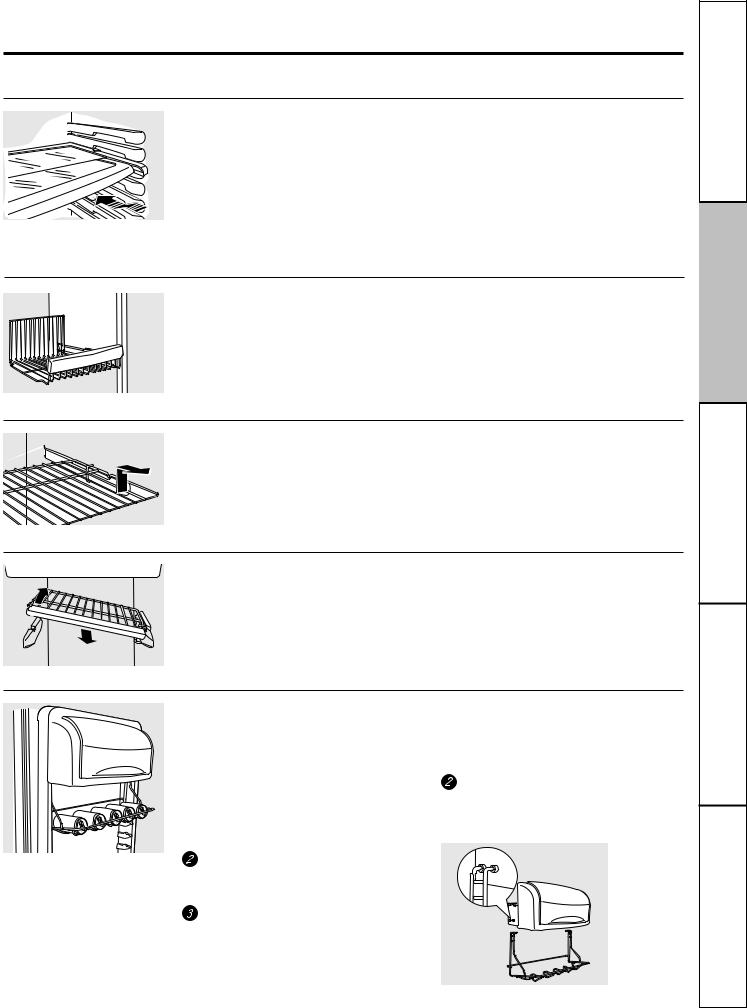
ge.com
Not all features are on all models.
QuickSpace™ Shelf (on some models)
This shelf splits in half and slides under itself for storageof tallitems on the shelf below.
This shelf can be removedand replaced or relocated just like Slide-Out Spillproof Shelves.
On some models, this shelf can not be used in the lowest position.
Freezer Baskets
To remove, slideout to the stop position, |
Make sure you push the baskets all the |
liftthe front pastthe stopposition, and |
way back in before you close the door. |
slideout. |
|
Slide-Out Freezer Shelves
To remove, slideout to the stop position, |
Make sure you push the shelves all the way |
lift the front pastthe stop position, and slide |
back in before you close the door. |
out from rib. |
|
Fixed Freezer Shelves
To remove, liftthe shelf up at the left side and |
NOTE FOR DISPENSER MODELS: In order |
then bring the shelf out. |
to take full advantage of the tilt-out ice bin |
|
(on somemodels), only store items on the |
|
shelf below the ice bin that are no taller |
|
than the lowest point on the bin. |
Door Wine/Beverage Rack (on some models)
This rack holds up to 5 cans or one bottle of wine.
The rack hangs from the sides of the dairy bin.
To remove:
 Empty the wine/beveragerack.
Empty the wine/beveragerack.
Holding the bottom of the dairybin, lift the front straight up, then liftup and out.
To detach the rack from the dairybin, pull the rack’s sidewires out of the holes on each sideof the dairy bin.
To replace:
 Reattach the rack to the sides of the bin.
Reattach the rack to the sides of the bin.
Engage the back side of the bin in the molded supports on the door. Then push down on the front of the bin. The bin will lock into place.
7
Instructions Operating Instructions Safety
Instructions |
Installation |
Support Consumer Tips Troubleshooting
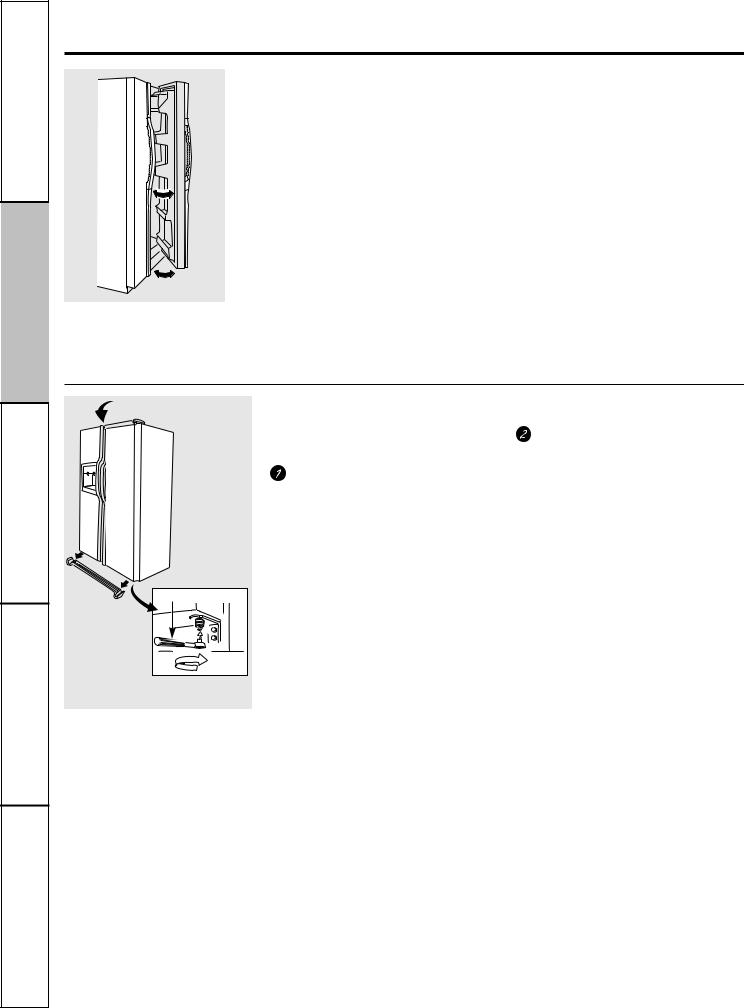
Operating Instructions Safety Instructions
Installation |
Instructions |
Consumer Support Troubleshooting Tips
About the refrigerator doors.
Refrigerator Doors
The refrigerator doors may feel different than the ones you are used to. The special door opening/closing featuremakes sure the doors close all the way and are securely sealed.
When opening and closing the door,you willnotice a stop position. If the door is opened past this stop point, the door will remainopen to allow you to load and unloadfood more easily. When the door is only partially open, it will automatically close.
The resistance you feel at the stop position will be reduced as the door is loaded with food.
When the door is only partially open, it will automatically close.
Beyond this stop the door will stay open.
Door Alignment
If doors are uneven,adjust the refrigerator door.
Using a 7/16″ socket wrench, turn the door adjusting screw to the right to raisethe door; to the left, to lower it. (A nylon plug, imbedded in the threads of the pin, prevents the pin from turning unless a wrench is used.)
|
7/16″ SocketWrench |
|
Toremovethe base |
|
|
grille,open the doors, |
|
|
removethe screw at |
|
|
each end of the base |
|
|
grilleand then pull |
Raise |
|
the grillestraightout. |
||
|
After one or two turns of the wrench, open and close the refrigerator door and check the alignment at the top of the doors.
8

About the crispers and pans. |
ge.com |
Not all features are on all models.
Fruit and Vegetable Crispers
Excess water that may accumulatein the bottom of the drawers should be wiped dry.
On some models, the bottom drawer has full extensionslidesthat allow full access to the drawer.
Adjustable Humidity Crispers
H I |
|
L O |
|
|
|
||
|
|
Slidethe control all the way to the HI setting |
Slide the control all the way to the LO |
|
|
to provide high humidityrecommended for |
setting to provide lower humidity levels |
|
|
most vegetables. |
recommended for mostfruits. |
Instructions Operating Instructions Safety
CO
LD
C O L D E S
T
Convertible Deli Pan (on some models)
The convertibledeli pan has its own cold air duct to allowa stream of coldair from the freezer compartment or refrigerator compartment to flow to the pan.
The variable temperature controlregulates the air flow from the ClimateKeeperAir Tower.
Set the control to the coldest setting to store fresh meats.
Set the control to cold to convert the pan to normal refrigerator temperature and provide extra vegetable storage space. The cold air duct is turned off. Variable settings between these extremes can be selected.
About crisper removal.
Not all features are on all models.
Crisper Removal
Crispers can easily be removed by pulling the drawer straightout and lifting the drawerup and over the stop location.
If the door prevents you from taking out
the drawers, first try to remove the door bins. If this does not offer enough clearance, the refrigerator will need to be rolled forward until the door opens enough to slide the drawers out. In some cases, when you roll the refrigerator out, you will need to move the refrigerator to the left or right as you roll it out.
9
Instructions |
Installation |
Support Consumer Tips Troubleshooting
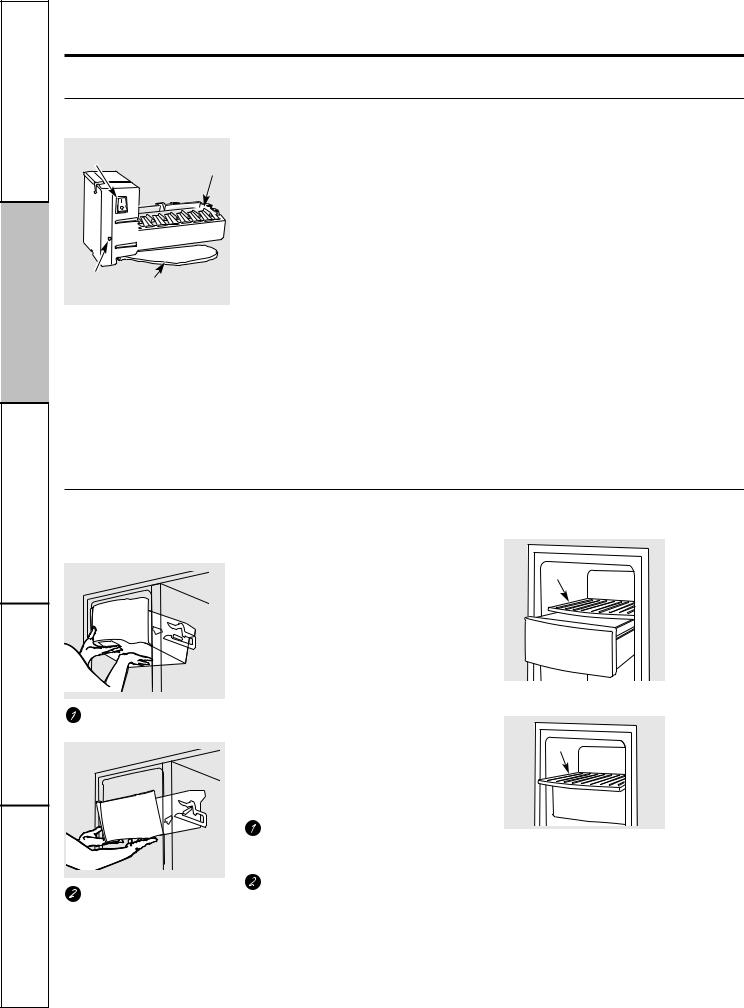
Operating Instructions Safety Instructions
Installation |
Instructions |
Consumer Support Troubleshooting Tips
About the automatic icemaker.
A newly installed refrigerator may take 12 to 24 hours to begin making ice.
Automatic Icemaker
Power
Switch
Icemaker
Green
FeelerArm
Power Light
The icemaker will produce sevencubes per cycle—approximately100–130 cubes in a 24-hour period, depending on freezer compartment temperature, room temperature, number of door openings and other use conditions.
See below for how to access ice and reach the power switch on dispenser models.
If the refrigerator is operatedbefore the water connection is madeto the icemaker, set the power switch in the O (off) position.
When the refrigerator has been connected to the water supply, set the power switch to the l (on) position.
Theicemaker will fill withwaterwhen it cools to 15°F (–10°C).A newly installed refrigerator maytake 12 to 24 hours to begin making ice cubes.
You willhear a buzzing sound each time the icemakerfills withwater.
Throwaway the first few batches of ice to allow the water line to clear.
Be surenothing interferes with the sweep of the feeler arm.
Whenthe bin fills to the level of the feeler arm, the icemaker will stop producing ice. It is normal for several cubes to be joined together.
If ice is not used frequently, old ice cubes will become cloudy, taste stale and shrink.
NOTE: In homes with lower-than-average water pressure, you may hear the icemaker cycle multiple times when making one batch of ice.
Models without a shelf above the ice bin
To access ice and reach the icemaker power switch:
Lift the bin, then pull it forward until the bin stops.
Lower the bin to access ice or reach the power switch.
NOTE: In order to take full advantage of the tilt-out ice bin, only store items on the shelf below the ice bin that are no taller than the lowest point on the bin.
Accessing Ice and Reaching the Power Switch on Dispenser Models
There are two types of ice storage bins
on dispenser models. One has a shelf above the bin, the other does not.
Special note about dispensermodels without a shelf above the ice bin:
■These models have a tilt-out ice bin. The bin can be tilted out as shown in the illustrations, and it willhold itself up whileyou take ice out or turn the icemaker power switchon and off.
Be sure to put the bin backin place before closing the door.
■To restore your ice level froman empty bucket stage, the following steps are recommended:
12 hours after the first batchof ice has fallen into the bin, dispense
3 to 4 cubes.
After an additional 6 hours,dispense 3 to 4 cubes again.
These steps will restore your ice level in the shortest amount of time.
Models with a shelf above the ice bin
Shelf
Ice Bin
To access ice, pull the bin forward.
Shelf
Ice Bin
To reach the power switch, pull the shelf straight out. Always be sure to replace the shelf.
10

About the ice and waterdispenser. (on some models) |
ge.com |
To Use the Dispenser
|
Select CUBED ICE |
, CRUSHED ICE |
|
|
or WATER |
. |
|
|
Press the glassgently against the top of the |
||
|
dispenser cradle. |
|
|
|
The spillshelf is not self-draining. To reduce |
||
|
water spotting,the shelf and its grilleshould |
||
|
be cleaned regularly. |
|
|
|
If no water is dispensed when the |
||
|
refrigerator is first installed, there may |
||
Spill Shelf |
be air in the water line system. Press the |
||
|
dispenser arm for at least two minutes to |
||
|
remove trapped air from the water line |
||
|
and to fill the water system. To flush out |
||
|
impurities in the water line, throw away |
||
|
the first six glassfuls of water. |
||
CAUTION: Never put fingers or any other objects into the ice crusher discharge opening.
Locking the Dispenser
Pressthe Lock Controls pad for 3 seconds to lock the dispenser and control panel. To unlock, press and hold the pad again for 3 seconds.
Dispenser Light
This pad turns the night light in the dispenser on and off.The light also comes on when the dispenser cradle is pressed. If this light burns out, it should be replaced with a 6 watt 12V maximum bulb.
Door Alarm (on some models)
To set the alarm, press this pad until the
indicator light comes on. This alarm will sound if either door is open for more than 3 minutes. The light goes out and the beeping stops when you close the door.
Important Facts About Your Dispenser
■Do not add ice from traysor bags to the storagedrawer. It may not crushor dispense well.
■Avoid overfillingglass with ice and use
of narrow glasses. Backed-upice can jam the chute or cause the door in the chuteto freeze shut. If ice is blocking the chute, poke it through witha wooden spoon.
■Beverages and foods should not be quick-chilled in the ice storage drawer. Cans, bottles or food packagesin the storagedrawer may cause the icemaker or auger to jam.
■To keep dispensed ice from missing the glass,put the glass close to, but not touching,the dispenser opening.
■Some crushed ice may be dispensed even though you selected CUBED ICE. This happens occasionally when a few cubes accidentally get directed to the crusher.
■After crushed ice is dispensed, some water may drip fromthe chute.
■Sometimes a small mound of snow will form on the door in the ice chute. This condition is normal and usually occurs when you have dispensed crushed ice repeatedly. The snow will eventually evaporate.
11
Instructions Operating Instructions Safety
Instructions |
Installation |
Support Consumer Tips Troubleshooting
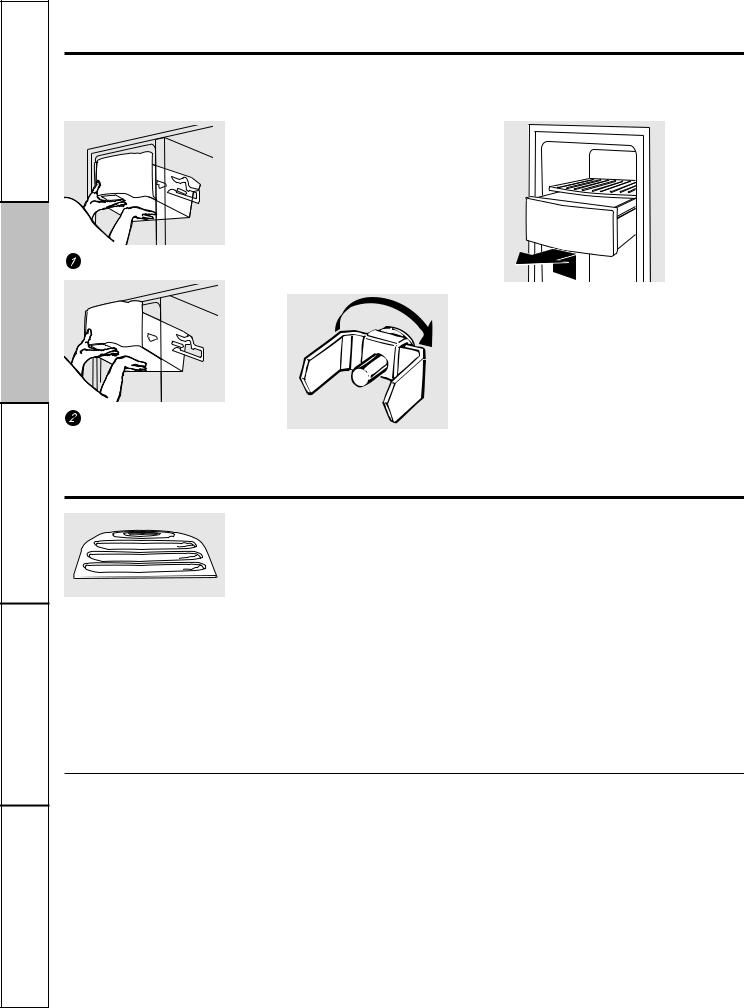
Operating Instructions Safety Instructions
Installation |
Instructions |
Consumer Support Troubleshooting Tips
About the ice and waterdispenser. (on some models)
Models without a shelf |
Removing and Replacing the Ice |
Models with a shelf |
above the ice bin |
Storage Bin on Dispenser Models |
above the ice bin |
To remove: |
|
To remove: |
Lift the bin, then pull it forward until the bin stops.
There are two types of ice storage bins on dispenser models. One has a shelf above the bin,the other does not.
Always set the icemaker power switch to the O (off) position before removing the ice bin.
When replacing either type of ice bin:
Always be sure to press it firmly into place. If it does not go all the way back, remove it and rotate the drivemechanism1/4 turn.
Then pushthe bin back again.
Rotate
Pull the bin straight out, then lift past the stop position.
Drive
Lift and pull forward again Mechanism to remove the bin.
Care and cleaningof the refrigerator.
Dispenser drip area
Cleaning the Outside
The dispenser drip area(on some models), beneath thegrille,should bewiped dry. Water left in this area may leavedeposits. Remove the deposits by adding undiluted vinegar to the well. Soak until the deposits disappear or become loose enough to rinseaway.
The dispenser cradle (on some models). Before cleaning, lock the dispenser by pressing and holding the LockControls pad for 3 seconds. Clean withwarmwater and baking soda solution – about a tablespoon (15 ml) of baking soda to a quart(1 liter)
of water. Rinsethoroughlyand wipe dry.
The door handles and trim. Clean with a cloth dampened with soapy water. Dry with a soft cloth.
Keep the outside clean. Wipe with a clean cloth lightly dampened with kitchen appliancewax or mild liquid dish detergent. Dry and polish with a clean, soft cloth.
Do not wipe the refrigerator with a soiled dish cloth or wet towel. These may leave a residue that can erode the paint. Do not use scouring pads, powdered cleaners, bleach or cleaners containing bleach because these products can scratch
and weaken the paint finish.
Cleaning the Inside
To help prevent odors, leave an open box of baking soda in the fresh food and freezer compartments.
Unplug the refrigerator beforecleaning.
If this is not practical, wring excess moisture out of sponge or clothwhen cleaning around switches, lights or controls.
Use warmwater and baking soda solution – about a tablespoon (15 ml) of baking soda to a quart (1 liter) of water.This both cleans and
neutralizesodors. Rinse and wipe dry.
12
Use of any cleaning solution other than thatwhich is recommended,especially thosethat contain petroleum distillates, can crack or damage the interior of the refrigerator.
Avoid cleaning cold glass shelves with hot water because the extreme temperature difference may cause them to break. Handle glass shelves carefully. Bumping tempered glass can cause it to shatter.
Do not wash any plastic refrigerator parts in the dishwasher.

Care and cleaning of the refrigerator. |
ge.com |
Behind the Refrigerator |
|
Be careful when moving the refrigerator away from the wall.All typesof floor coverings can be damaged,particularly cushioned coverings and those with embossed surfaces.
Pull the refrigerator straight out and return it to position by pushing it straight
in. Moving the refrigerator in a side direction may result in damageto the floor covering or refrigerator.
When pushing the refrigerator back, make sure you don’t roll over the power cord or icemaker supply line (on some models).
Preparing for Vacation
For long vacations or absences, remove food and unplug the refrigerator.Clean the interior with a baking soda solution of one tablespoon (15 ml) of baking soda to one quart (1 liter) of water.Leavethe doors open.
Set the icemaker power switchto the O (off) position and shut off the water supplyto the refrigerator.
If the temperature can drop below freezing, have a qualified servicer drain the water supply system (on some models) to prevent serious property damage due to flooding.
Preparing to Move
Secure all loose items such as shelvesand drawers by taping them securely in place to prevent damage.
When using a hand truck to move the refrigerator, do not rest the front or back of the refrigerator against the hand truck. This could damagethe refrigerator.Handle only from the sides of the refrigerator.
Be sure the refrigerator stays in an upright position during moving.
13
Instructions Operating Instructions Safety
Instructions |
Installation |
Support Consumer Tips Troubleshooting
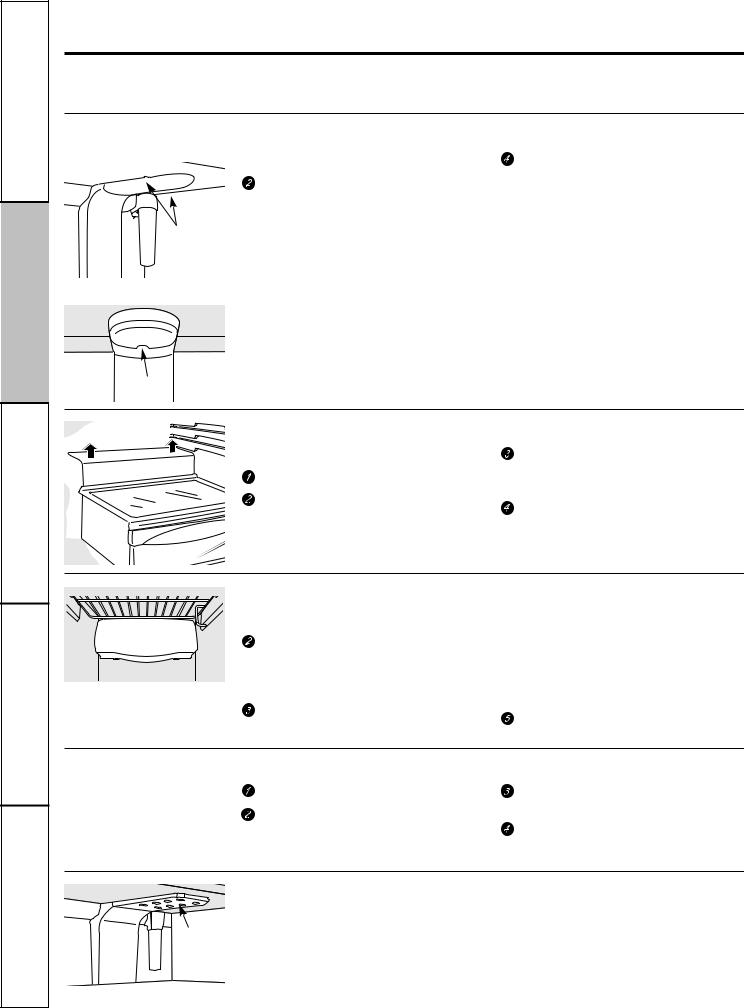
Operating Instructions Safety Instructions
Installation |
Instructions |
Consumer Support Troubleshooting Tips
Replacing the lightbulbs.
NOTE: Turning the refrigerator off via the controls on the touch panel does not shut off electrical power to the refrigerator.
Your light shield will look like one of the following:
Tabs
OR
Refrigerator Compartment—Upper Light
 Unplug the refrigerator.
Unplug the refrigerator.
The bulbs are located at the top of
the compartment, insidethe light shield. On some models,a screw at the front of the light shieldwillhaveto be removed. On other models,the screwis located in the pocket located at the back of
the shield.
 To remove the light shield,on some models, press in on the tabson the sides of the shieldand slideforward and out. On other models,just slide the shield forwardand out.
To remove the light shield,on some models, press in on the tabson the sides of the shieldand slideforward and out. On other models,just slide the shield forwardand out.
After replacing the bulb with an appliance bulb of the same or lower wattage, replace the light shield and screw. When replacing the light shield, make surethat the tabs at the back of the shield fit into the slots at the back of the light shield housing.
 Plug the refrigerator back in.
Plug the refrigerator back in.
Refrigerator Compartment—Lower Light
This light is located above the top drawer. |
After replacing the bulb with an appliance |
|
Unplug the refrigerator. |
bulb of the same or lower wattage, |
|
replace the shield. |
||
|
Lift the light shield up and pull it out.
Plug the refrigerator back in.
Freezer Compartment
 Unplugthe refrigerator.
Unplugthe refrigerator.
Remove the shelf just above the light shield.(The shelf will be easier to remove if it is emptied first.) Remove the screw at the top of the light shield.
To remove the light shield, press in on the sides, and lift up and out.
 Replace the bulb with an appliance bulb of the same or lower wattage, and reinstall the light shield. When reinstalling the light shield, make sure the top tabs snap securely into place. Replace the screw.
Replace the bulb with an appliance bulb of the same or lower wattage, and reinstall the light shield. When reinstalling the light shield, make sure the top tabs snap securely into place. Replace the screw.
Reinstall the shelf and plug the refrigerator back in.
Dispenser
Unplugthe refrigerator. |
Replace the bulb with a bulb |
The bulb is located on the dispenser |
of the same size and wattage. |
|
|
under the control panel. Remove the light |
Plug the refrigerator back in. |
bulbby turning it counterclockwise. |
|
|
Refrigerator Compartment (on some models) |
|
|
There is an LED lighting displayin the top |
|
LED |
of the refrigerator compartment on some |
|
models. If this assembly needs to be |
||
Lighting |
||
Display |
replaced, call GE Service at 1.800.432.2737 |
|
|
in the United States or 1.800.561.3344 |
|
14 |
in Canada. |
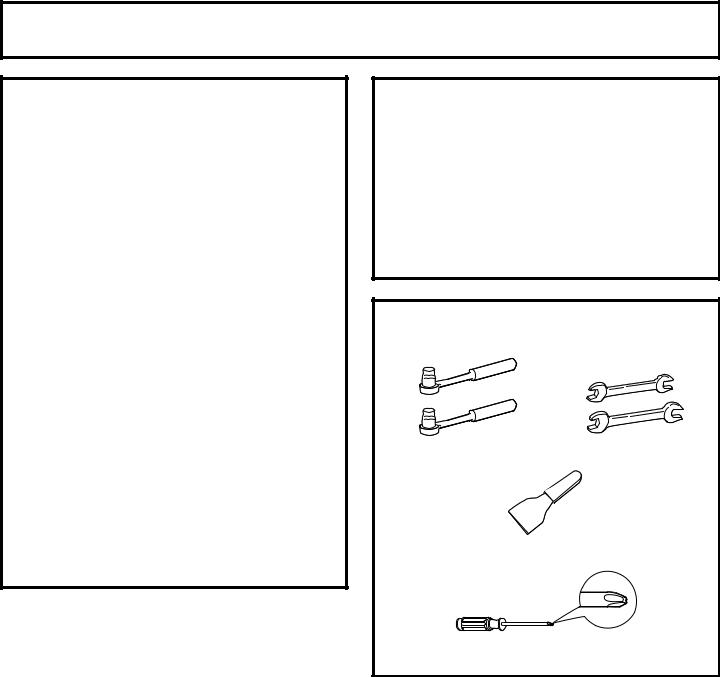
Installation |
Refrigerator |
Instructions |
Models 22, 23, 25, 26 & 27 |
Questions? Call 800.GE.CARES (800.432.2737) or Visit our Website at: ge.com
In Canada, call 1.800.561.3344 or Visit our Website at: www.geappliances.ca
BEFORE YOU BEGIN
Read these instructions completely and carefully.
• IMPORTANT — Save these instructions for local inspector’s use.
• IMPORTANT — Observe all governing codes and ordinances.
•Note to Installer – Be sure to leave these instructions with the Consumer.
•Note to Consumer – Keep these instructions for future reference.
•Skill level – Installation of this appliance requires basic mechanical skills.
•Completion time – Refrigerator Installation
30 minutes
Water Line Installation
30minutes
•Proper installation is the responsibility of the installer.
•Product failure due to improper installation is not covered under the Warranty.
If the refrigerator has already been installed, remove the base grille (see Step 2 in Moving
the Refrigerator), then skip to Step 5 in Installing the Refrigerator.
PREPARATION
WATER SUPPLY TO THE ICEMAKER
If the refrigerator has an icemaker, it will have to be connected to a cold water line. A GE water
supply kit (containing tubing, shutoff valve, fittings and instructions) is available at extra cost from your dealer, by visiting our Website at ge.com
(in Canada at www.geappliances.ca) or from Parts and Accessories, 800.626.2002 (in Canada 1.888.261.3055).
TOOLS YOU WILL NEED
3/8″ and 5/16″ Socket |
|
1/2″ and 7/16″ Wrench |
|
|
|
Plastic Putty Knife
Phillips Head Screwdriver
15
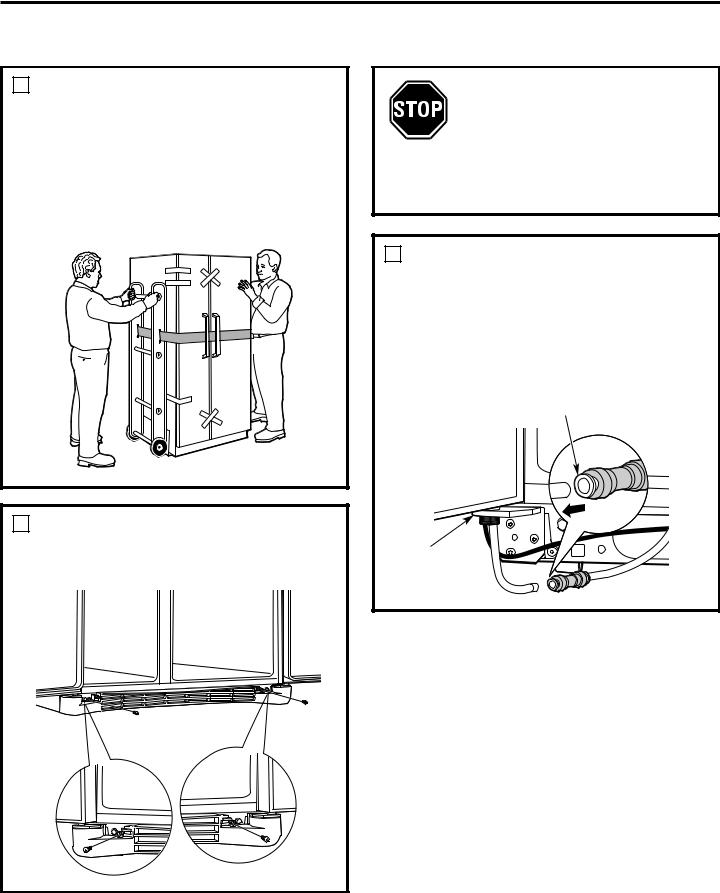
Installation Instructions
MOVING THE REFRIGERATOR
1LOADING THE RERIGERATOR ONTO A HAND TRUCK
Leave all tape and door pads on doors until the refrigerator is in its final location.
To move the refrigerator, use a padded hand truck. Center the refrigerator on the hand truck and secure the strap around the refrigerator.
DO NOT OVERTIGHTEN THE STRAP.
2 REMOVE THE BASE GRILLE
Remove the grille by removing the two Phillips head screws.
If the refrigerator must go through
any entrance that is less than 38″ wide, the doors must be removed. Proceed to Step 3.
DO NOT remove the handles.
If all entrances are more than 38″ wide, skip to Installing the Refrigerator.
3DISCONNECT THE WATER COUPLING (on some models)
If the refrigerator has a water dispenser, there is a water line from the cabinet into the bottom hinge on the freezer door that must be disconnected.
To disconnect, push in on the white collar of the coupling and pull out the tubing.
White collar
Bottom freezer hinge
16

Installation Instructions
4DISCONNECT THE POWER COUPLING (on some models)
If the refrigerator has a water dispenser, there is a power line (harness) from the cabinet into the bottom hinge on the freezer door that must be disconnected.
To disconnect, pull apart at the coupling.
Bottom freezer hinge
5DISCONNECT THE ELECTRICAL CONNECTORS (on some models)
If the refrigerator has a refreshment center, there are electrical connectors (harnesses) from the cabinet into the bottom hinge on the refrigerator door that must be disconnected.
To disconnect, pull apart each connector.
Bottom refrigerator hinge
6CLOSE THE FREEZER AND REFRIGERATOR DOORS
7 REMOVE THE FREEZER DOOR
ARemove the freezer door top hinge cover by either squeezing it and pulling it up or by prying it off with a plastic putty knife.
B Remove the two 5/16″ hex head screws, then lift the hinge straight up to free the hinge pin.
5/16″ Hex Head
C Open the freezer door to 90.°
90°
17
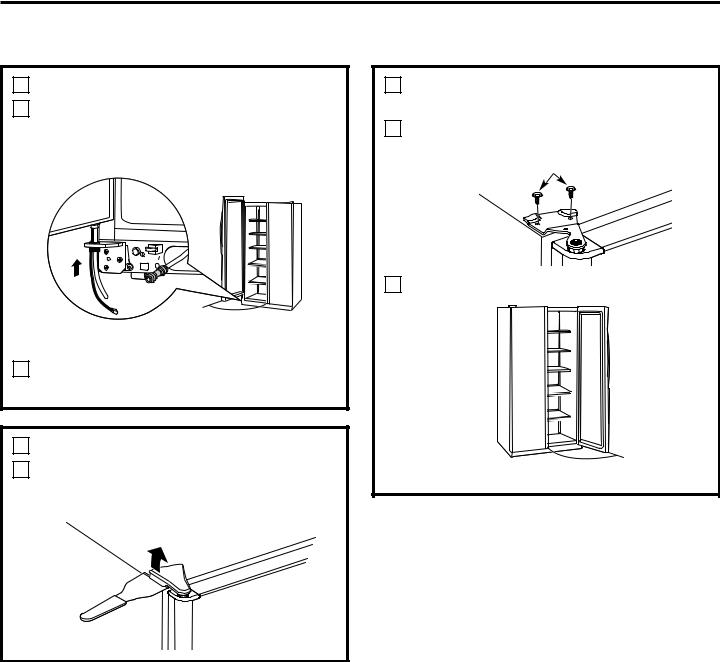
Installation Instructions
MOVING THE REFRIGERATOR (CONT.)
7 REMOVE THE FREEZER DOOR (cont.)
DAs one person slowly lifts the freezer door up and off the bottom hinge, the second person should carefully guide the water line and power line (harness) through the bottom hinge.
90°
ESet the door on a non-scratching surface with the inside up.
8 REMOVE THE REFRIGERATOR DOOR
ARemove the refrigerator door top hinge cover by either squeezing it and pulling it up or by prying it off with a plastic putty knife.
8REMOVE THE REFRIGERATOR DOOR (cont.)
BRemove the two 5/16″ hex head screws, then lift the hinge straight up to free the hinge pin.
5/16″ Hex Head
C Open the refrigerator door to 90.°
90°
18
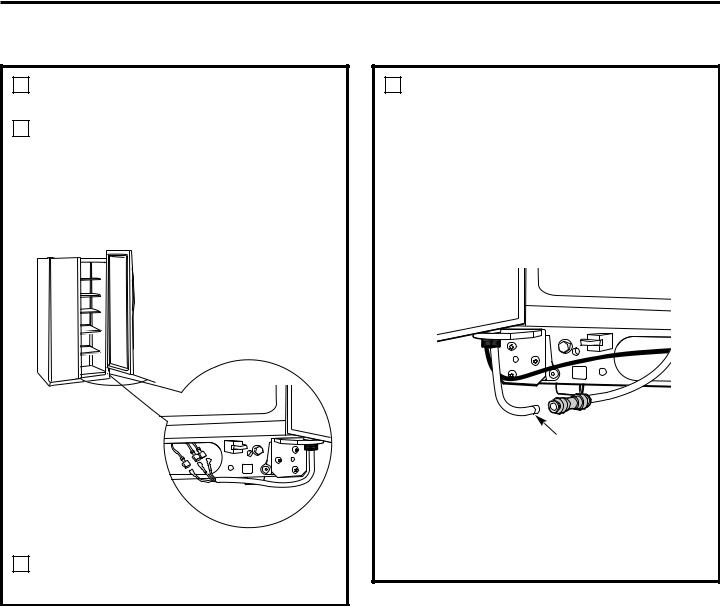
Installation Instructions
8REMOVE THE REFRIGERATOR DOOR (cont.)
DLift the refrigerator door up and off the bottom hinge.
If the refrigerator has a refreshment center, one person should slowly lift the door up and off the bottom hinge and the second person should carefully guide the electrical lines (harnesses) through the bottom hinge.
90°
Refreshment Center Models only
ESet the door on a non-scratching surface with the inside up.
9 REPLACING THE DOORS
To replace the doors, simply reverse steps 3 through 8.
However, please note the following:
•When lowering the doors onto the bottom hinges, make sure the second person carefully guides the tube and harnesses through the holes in the hinges.
•When connecting the water line, make sure you insert the tubing all the way to the mark.
Mark
•Do not pinch the tubing and harnesses when placing the doors on the bottom hinges.
•When connecting the power line and the electrical lines (refreshment center models only), be sure that the connectors are seated together fully.
19

Installation Instructions
INSTALLING THE REFRIGERATOR
REFRIGERATOR LOCATION
•Do not install the refrigerator where the temperature will go below 60°F (16°C) because it will not run often enough to maintain proper temperatures.
•Do not install the refrigerator where the temperature will go above 100°F (37°C) because it will not perform properly.
•Install it on a floor strong enough to support it fully loaded.
CLEARANCES
Allow the following clearances for ease of installation, proper air circulation and plumbing and electrical connections:
Sides |
1/8″ (4 mm) |
Top |
1″ (25 mm) |
Back |
1″ (25 mm) |
20
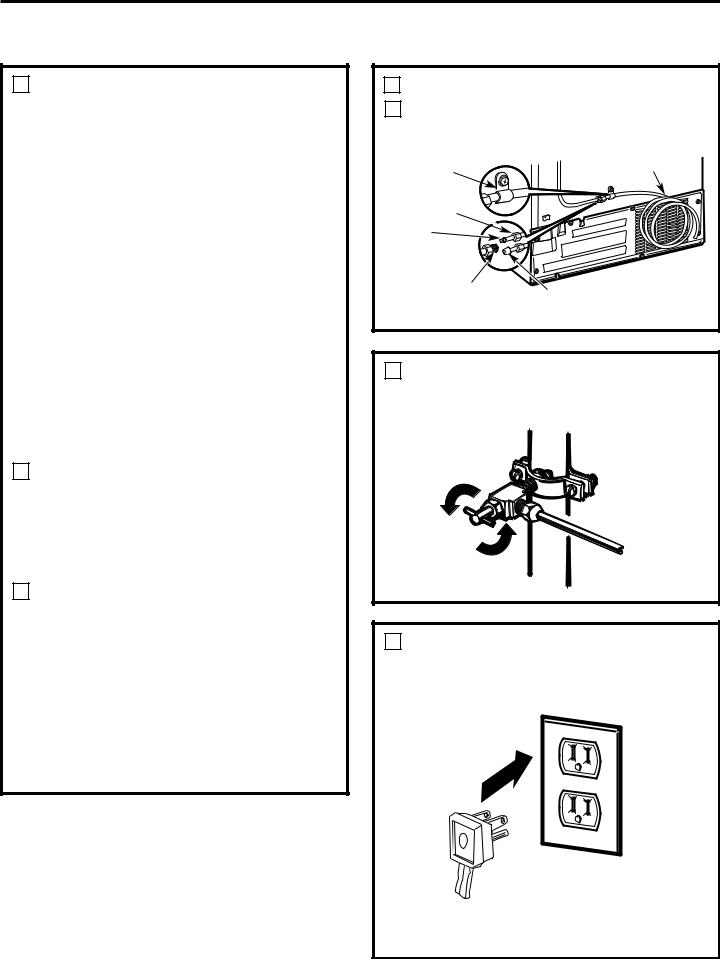
Installation Instructions
1
A
B
CONNECTING THE REFRIGERATOR TO THE HOUSE WATERLINE (icemaker and dispenser models)
A cold water supply is required for automatic icemaker and dispenser operation. If there
is not a cold water supply, you will need to provide one. See “Installing the Water Line” section.
NOTES:
•Before making the connection to the refrigerator, be sure the refrigerator power cord is not plugged into the wall outlet.
•If your refrigerator does not have a water filter, we recommend installing one if your water supply has sand or particles that could clog the screen of the refrigerator’s water valve. Install it in the water line near the refrigerator. If using GE SmartConnect™ Refrigerator Tubing Kit, you will need an additional tube (WX08X10002) to connect the filter. Do not cut plastic tube to install filter.
If you are using copper tubing, place a compression nut and ferrule (sleeve) onto the end of the tubing coming from the house cold water supply.
If you are using the GE SmartConnect™ tubing, the nuts are already assembled to the tubing.
If you are using copper tubing, insert the end of the tubing into the refrigerator connection, at the back of the refrigerator,
as far as possible. While holding the tubing, tighten the fitting.
If you are using GE SmartConnect™ tubing, insert the molded end of the tubing into the refrigerator connection, at the back of the refrigerator, and tighten the compression nut until it is hand tight. Then tighten one additional turn with a wrench. Overtightening may cause leaks.
1 CONNECTING THE REFRIGERATOR (cont.)
CFasten the tubing into the clamp provided to hold it in position. You may need to pry open the clamp.
Tubing Clamp |
1/4″ Tubing |
|
1/4″ Compression Nut
Ferrule (sleeve)
Refrigerator |
SmartConnect™ Tubing |
|
Connection |
||
|
2 TURN ON THE WATER SUPPLY
Turn the water on at the shutoff valve (house water supply) and check for any leaks.
3 PLUG IN THE REFRIGERATOR
Before plugging in the refrigerator, make sure the icemaker power switch is set to the O (off) position.
See the grounding information attached to the power cord.
21

Installation Instructions
INSTALLING THE REFRIGERATOR (CONT.)
4 PUT THE REFRIGERATOR IN PLACE
Move the refrigerator to its final location.
5 LEVEL THE REFRIGERATOR
The refrigerator can be leveled by adjusting the rollers located near the bottom hinges.
Rollers
Raise
Rollers have three purposes:
•Rollers adjust so the door closes easily when opened about halfway. (Raise the front about 5/8″ [16 mm] from the floor.)
•Rollers adjust so the refrigerator is firmly positioned on the floor and does not wobble.
•Rollers allow you to move the refrigerator away from the wall for cleaning.
To adjust the rollers:
•Turn the roller adjusting screws
clockwise to raise the refrigerator, counterclockwise to lower it. Use a 3/8″ hex socket or wrench, or an adjustable wrench.
6
A
B
LEVEL THE DOORS
Adjust the refrigerator door to make the doors even at the top.
To align:
Using a 7/16″ wrench, turn the door adjusting screw to the right to raise the door, to the left to lower it.
NOTE:
A nylon plug, imbedded in the threads
of the pin, prevents the pin from turning unless a wrench is used.
After one or two turns of the wrench, open and close the refrigerator door and check the alignment at the top of the doors.
Doors should be even at top
Raise
7/16″ wrench
Roller adjusting screw
22
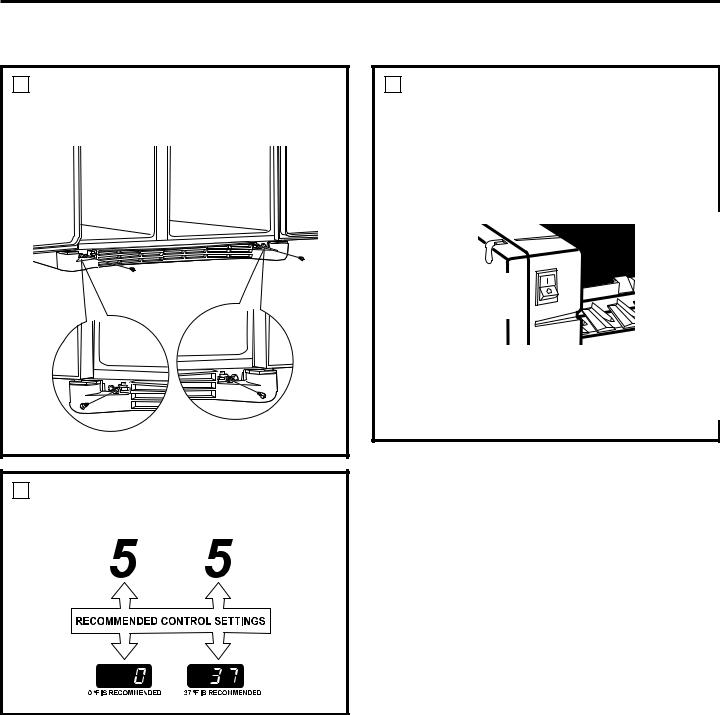
Installation Instructions
7 REPLACE THE BASE GRILLE
Replace the grille by installing the two Phillips head screws.
8 SET THE CONTROLS
Set the controls to the recommended setting.
9 START THE ICEMAKER
Set the icemaker power switch to the I (on) position. The icemaker will not begin to operate until it reaches its operating temperature of 15°F (–9°C) or below. It will then begin operation automatically. It will take 2–3 days to fill
the ice bin.
Power switch
NOTE:
In lower water pressure conditions, the water valve may turn on up to 3 times to deliver enough water to the icemaker.
23

Installation Instructions
INSTALLING THE WATER LINE (ICEMAKER & DISPENSER MODELS)
BEFORE YOU BEGIN
Recommendedcopper watersupplykits are WX8X2, WX8X3 or WX8X4, depending on the amount of tubing you need. Approved plastic watersupplylines are GE SmartConnect™ Refrigerator Tubing (WX08X10002, WX08X10006, WX08X10015 and WX08X10025). Whenconnectingyour refrigerator to a GEReverse Osmosis Water System,the only approved instalation is with a GE RVKit. For otherreverseosmosis water systems, follow the manufacturer’s recommendations. If the water supply to the refrigerator is from a Reverse Osmosis Water Filtration System AND
the refrigerator also has a water filter, use the refrigerator’s filter bypass plug. Using the refrigerator’s water filtration cartridge in
conjunction with the RO filter can result in hollow ice cubes and slower water flow from the water dispenser.
This water line installation is not warranted by the refrigerator or icemaker manufacturer. Follow these instructions carefully to minimize the risk of expensive water damage.
Water hammer (water banging in the pipes) in house plumbing can cause damage to refrigerator parts and lead to water leakage or flooding. Call a qualified plumber to correct water hammer before installing the water supply line to the refrigerator. To prevent burns and product damage, do not hook up the water line to the hot water line.
If you use your refrigerator before connecting the water line, make sure the icemaker power switch is in the O (off) position.
Do not install the icemaker tubing in areas where temperatures fall below freezing.
When using any electrical device (such as a power drill) during installation, be sure the device is double insulated or grounded in a manner to prevent the hazard of electric shock, or is battery powered.
All installations must be in accordance with local plumbing code requirements.
WHAT YOU WILL NEED
•Copper or GE SmartConnect™ Refrigerator Tubing kit, 1/4″ outer diameter to connect the refrigerator to the water supply. If using copper, be sure both ends of the tubing are cut square.
To determine how much tubing you need: measure the distance from the water valve on the back of the refrigerator to the water supply pipe. Be sure there is sufficient extra tubing to allow the refrigerator to move out from the wall after installation.
GE SmartConnect™ Refrigerator Tubing Kits are available in the following lengths:
2′ (0.6 m) – WX08X10002
6′ (1.8 m) – WX08X10006
15′ (4.6 m) – WX08X10015
25′ (7.6 m) – WX08X10025
24
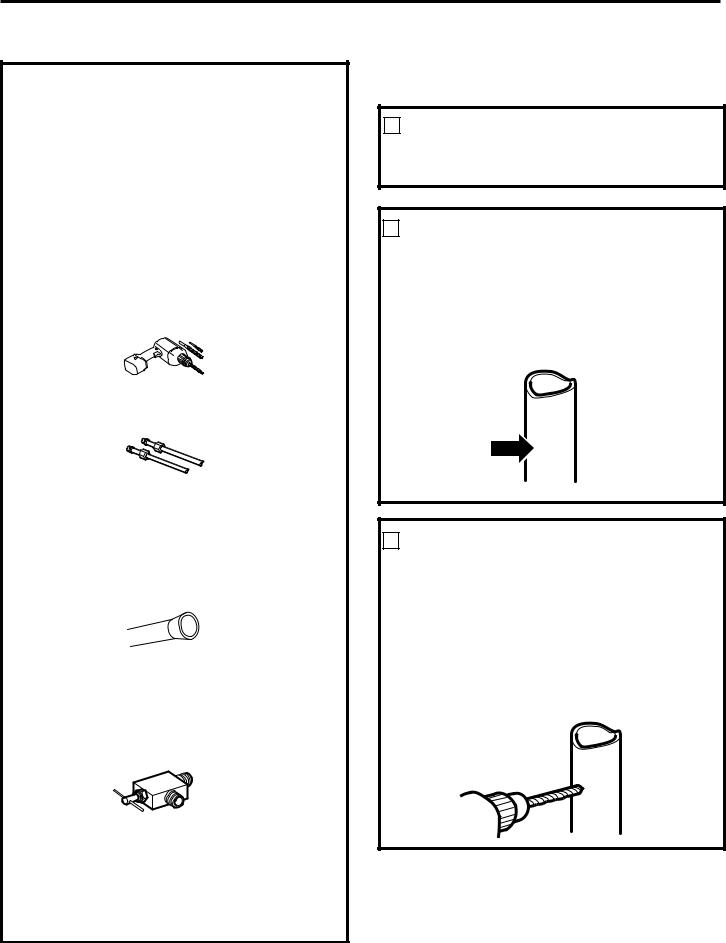
Installation Instructions
WHAT YOU WILL NEED (CONT.)
NOTE: The only GE approved plastic tubing is that supplied in GE SmartConnect™
Refrigerator Tubing kits. Do not use any other plastic water supply line because the line is under pressure at all times. Certain types of plastic will crack or rupture with age and cause water damage to your home.
•A GE water supply kit (containing tubing, shutoff valve and fittings listed below) is available at extra cost from your dealer or from Parts
and Accessories, 800.626.2002 (in Canada 1.888.261.3055).
•A coldwater supply. The waterpressure mustbe between 20 and 120 p.s.i.(1.4–8.1bar).
•Power drill.
•1/2″ or adjustable wrench.
•Straight and Phillips blade screwdriver.
•Two 1/4″ outer diameter compression nuts and 2 ferrules (sleeves)—to connect the copper tubing to the shutoff valve and the refrigerator water valve.
OR
•If you are using a GE SmartConnect™ Refrigerator Tubing kit, the necessary fittings are preassembled to the tubing.
•If your existing copper water line has a flared fitting at the end, you will need an adapter (available at plumbing supply stores) to connect the water line to the refrigerator OR you can cut off the flared fitting with a tube cutter and then use a compression fitting. Do not cut formed end from GE SmartConnect™ Refrigerator tubing.
•Shutoff valve to connect to the cold water line. The shutoff valve should have a water inlet with a minimum inside diameter of 5/32″ at the point of connection to the COLD WATERLINE. Saddle-type shutoff valves are included in many water supply kits. Before purchasing, make sure a saddle-type valve complies with your local plumbing codes.
Install the shutoff valve on the nearest frequently used drinking water line.
1 SHUT OFF THE MAIN WATER SUPPLY
Turn on the nearest faucet long enough to clear the line of water.
2 CHOOSE THE VALVE LOCATION
Choose a location for the valve that is easily accessible. It is best to connect into the side of a vertical water pipe. When it is necessary to connect into a horizontal water pipe, make the connection to the top or side, rather than at the bottom, to avoid drawing off any sediment from the water pipe.
3 DRILL THE HOLE FOR THE VALVE
Drill a 1/4″ hole in the water pipe (even if using a self-piercing valve), using a sharp bit. Remove any burrs resulting from drilling the hole in
the pipe.
Take care not to allow water to drain into the drill.
Failure to drill a 1/4″ hole may result in reduced ice production or smaller cubes.
25
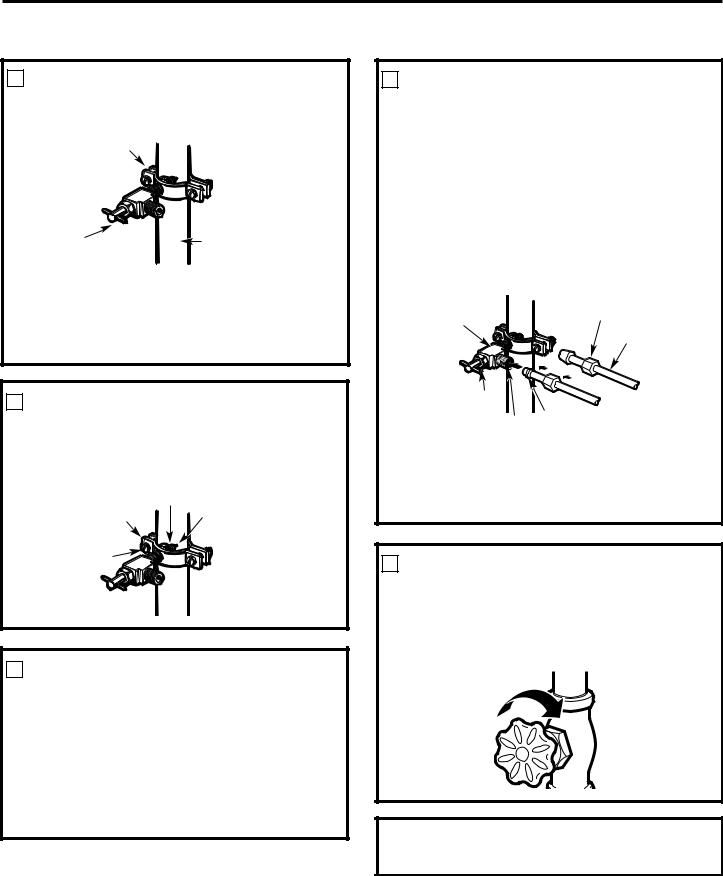
Installation Instructions
INSTALLING THE WATER LINE (CONT.)
4 FASTEN THE SHUTOFF VALVE
Fasten the shutoff valve to the cold water pipe with the pipe clamp.
Pipe Clamp
Saddle-Type |
Vertical Cold Water Pipe |
Shutoff Valve |
|
NOTE: Commonwealth of Massachusetts Plumbing Codes 248CMR shall be adhered to. Saddle valves are illegal and use is not permitted in Massachusetts. Consult with your licensed plumber.
5 TIGHTEN THE PIPE CLAMP
Tighten the clamp screws until the sealing washer begins to swell.
NOTE: Do not overtighten or you may crush the tubing.
|
Washer |
Pipe Clamp |
Inlet End |
|
|
Clamp |
|
Screw |
|
6 ROUTE THE TUBING
Route the tubing between the cold water line and the refrigerator.
Route the tubing through a hole drilled in the wall or floor (behind the refrigerator or adjacent base cabinet) as close to the wall as possible.
NOTE: Be sure there is sufficient extra tubing to allow the refrigerator to move out from the wall after installation.
7 CONNECT THE TUBING TO THE VALVE
Place the compression nut and ferrule (sleeve) for copper tubing onto the end of the tubing and connect it to the shutoff valve.
Make sure the tubing is fully inserted into
the valve. Tighten the compression nut securely.
For plastic tubing from a GE SmartConnect™ Refrigerator Tubing kit, insert the molded end of the tubing into the shutoff valve and tighten compression nut until it is hand tight, then tighten one additional turn with a wrench. Overtightening may cause leaks.
Saddle-Type |
Compression Nut |
Shutoff Valve |
|
SmartConnect™
Tubing
Packing Nut
Ferrule (sleeve)
Outlet Valve
NOTE: Commonwealth of Massachusetts Plumbing Codes 248CMR shall be adhered to. Saddle valves are illegal and use is not permitted in Massachusetts. Consult with your licensed plumber.
8 FLUSH OUT THE TUBING
Turn the main water supply on and flush out the tubing until the water is clear.
Shut the water off at the water valve after about one quart (1 liter) of water has been flushed through the tubing.
To complete the installation of the refrigerator, go back to Step 1 in Installing the Refrigerator.
26
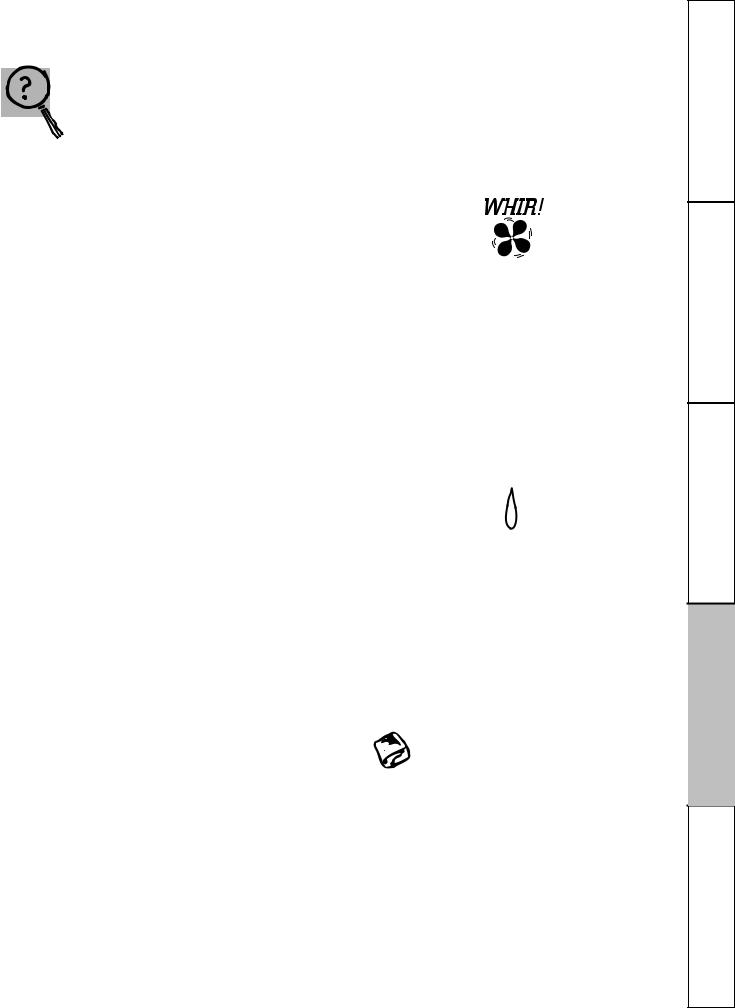
Normal operatingsounds. |
ge.com |
|
|
|
|
Newer refrigerators sound different from older refrigerators. Modern refrigerators havemorefeatures and use newer technology.
Do you hear what I hear? These sounds are normal.
|
|
|
HUMMM... |
|
|
|
|
||
|
|
|
|
WHOOSH... |
|
|
|
|
|
|
|
|
|
|
|
|
|||
|
|
|
|
|
|
|
|
||
|
|
|
|
|
|
|
|
||
■ The new high efficiency compressor may run faster |
■ You may hear the fans spinning at high speeds. |
||||||||
and longer than your old refrigerator and you may |
|||||||||
hear a high-pitched hum or pulsating sound while |
|
This happens when the refrigerator is first plugged in, |
|||||||
it is operating. |
|
when the doors are opened frequently or when a large |
|||||||
■ Sometimes the refrigeratorruns for an extendedperiod, |
|
amount of food is added to the refrigerator or freezer |
|||||||
|
compartments. The fans are helping to maintain the |
||||||||
especially when the doors are opened frequently.This |
|
||||||||
|
correct temperatures. |
||||||||
meansthatthe FrostGuard™ feature is working to prevent |
|
||||||||
freezer burnand improvefood preservation. |
■ If either door is open for over 3 minutes, you may hear |
||||||||
■ You may hear a whooshingsound when the doorsclose. |
|
the fans come on in order to cool the light bulbs. |
|||||||
■ The fans change speeds in order to provide optimal |
|||||||||
This is due to pressureequalizing within the refrigerator. |
|||||||||
|
|
|
|
|
|
cooling and energy savings. |
|||
|
|
|
|
|
|
|
|||
|
|
CLICKS, POPS, |
|
|
WATER SOUNDS |
||||
CRACKS and CHIRPS |
|
|
|
|
|||||
■ You may hear cracking or popping sounds when the |
|
|
|
|
|||||
refrigerator is first plugged in. This happens as the |
■ |
The flow of refrigerant through the freezer cooling coils |
|||||||
refrigerator cools to the correct temperature. |
|||||||||
|
may make a gurgling noise like boiling water. |
||||||||
|
|
|
|
|
|
||||
■ Electronic dampers click open and closed to provide |
■ |
Water dropping on the defrost heater can cause a |
|||||||
optimal cooling and energy savings. |
|||||||||
|
sizzling, popping or buzzing sound during the defrost |
||||||||
|
|
|
|
|
|
||||
■ The compressor may cause a clicking or chirping |
|
cycle. |
|||||||
sound when attempting to restart (this could take |
■ |
A water dripping noise may occur during the defrost |
|||||||
up to 5 minutes). |
|||||||||
|
cycle as ice melts from the evaporator and flows into |
||||||||
|
|
|
|
|
|
||||
■ The electronic control board may cause a clicking |
|
the drain pan. |
|||||||
sound when relays activate to control refrigerator |
■ |
Closing the door may cause a gurgling sound due to |
|||||||
components. |
|||||||||
|
pressure equalization. |
||||||||
|
|
|
|
|
|
||||
■ Expansion and contraction of cooling coils during and |
|
|
|
|
|||||
after defrost can cause a cracking or popping sound. |
|
|
For additional information on normal |
|
|||||
■ On models with an icemaker, after an icemaking cycle, |
|
|
icemaker and dispenser operating sounds, |
|
|||||
you may hear the ice cubes dropping into the ice |
|
|
see the About the automatic icemaker |
|
|||||
bucket. |
|
|
and About the ice and water dispenser |
|
|||||
|
|
|
|
|
|
|
sections. |
|
|
|
|
|
|
|
|
|
|
|
|
27
Instructions Operating Instructions Safety
Instructions |
Installation |
Support Consumer Tips Troubleshooting

Operating Instructions Safety Instructions
Installation |
Instructions |
Consumer Support Troubleshooting Tips
Before you call for service…
Troubleshooting Tips
Save time and money! Review the charts on the following pages first and you may not need to call for service.
Problem |
|
Possible Causes |
What To Do |
|
|
|
|
Refrigeratordoes not |
|
Refrigeratorin defrost cycle. |
• Wait about 30 minutesfor defrost cycleto end. |
operate |
|
|
|
|
Eitherorboth controlsset to OFF. |
• Set the controls to a lower temperature setting. |
|
|
|
||
|
|
|
|
|
|
Refrigerator is unplugged. |
• Push the plug completely into the outlet. |
|
|
|
|
|
|
The fuse is blown/circuit |
• Replace fuse or reset the breaker. |
|
|
breaker is tripped. |
|
|
|
|
|
|
|
Refrigerator is in showroom mode. • Unplug the refrigerator and plug it back in. |
|
|
|
|
|
Vibration or rattling |
|
Rollers need adjusting. |
• See Rollers. |
(slight vibration |
|
|
|
is normal) |
|
|
|
Motor operatesfor long periods or cycles on and off frequently. (Modern refrigerators with more storage space and a larger freezerrequire more operating time. They start and stop often to maintain even temperatures.)
Normalwhenrefrigerator |
• Wait 24 hours for the refrigerator to completely |
is first pluggedin. |
cool down. |
|
|
Often occurs when large |
• This is normal. |
amounts of food are |
|
placed in refrigerator. |
|
|
|
Door left open. |
• Check to see if package is holding door open. |
|
|
Hot weather or frequent |
• This is normal. |
door openings. |
|
|
|
Temperature controls |
• See About the controls. |
set at the coldest |
|
setting. |
|
Refrigeratoror freezer |
Temperaturecontrolnot set |
• See About the controls. |
compartment too warm |
coldenough. |
|
|
|
|
|
Warmweather or frequent |
• Set the temperature controlone step colder. |
|
door openings. |
See About the controls. |
|
|
|
|
Door left open. |
• Check to see if package is holding door open. |
|
|
|
Frost or ice crystals |
Door left open. |
• Check to see if package is holdingdooropen. |
on frozen food |
|
|
Too frequent or too long |
|
|
(frost within package |
|
|
door openings. |
|
|
is normal) |
|
|
|
|
|
|
|
|
Divider between |
Automatic energysaver |
• This helps preventcondensationon the outside. |
refrigerator and freezer |
system circulates warm |
|
compartments |
liquid around frontedge |
|
feels warm |
of freezer compartment. |
|
|
|
|
Automatic icemaker |
Icemakerpowerswitch |
• Set the power switch to the l (on) position. |
does not work |
is in the O (off) position. |
|
|
|
|
|
Water supply turned off or |
• See Installing the water line. |
|
not connected. |
|
|
|
|
|
Freezer compartment |
• Wait 24 hours for the refrigerator to completely |
|
too warm. |
cool down. |
|
|
|
|
Piled up cubesin the storage |
• Level cubes by hand. |
|
bin causethe icemaker |
|
|
to shut off. |
|
|
|
|
|
Ice cubesstuck in icemaker. |
• Turn off the icemaker,remove cubes, and turn the |
|
(Green power light on |
icemaker back on. |
|
icemaker blinking). |
|
28 |
|
|

ge.com
Problem |
|
Possible Causes |
What To Do |
|
|
|
|
Ice cubeshave |
|
Ice storage bin needs cleaning. |
• Empty and wash bin. Discard old cubes. |
odor/taste |
|
|
|
|
Food transmitting odor/taste |
• Wrap foods well. |
|
|
|
||
|
|
to ice cubes. |
|
|
|
|
|
|
|
Interior of refrigerator |
• See Care and cleaning. |
|
|
needs cleaning. |
|
Small or hollow cubes |
|
Waterfilter clogged. |
• Replace filter cartridge withnew cartridge or with plug. |
|
|
|
|
Slow ice cubefreezing |
|
Door left open. |
• Check to see if package is holdingdooropen. |
|
|
|
|
|
|
Temperature control not set |
• See About the controls. |
|
|
coldenough. |
|
Orange glowin |
|
Defrost heater is on. |
• Thisis normal. |
the freezer |
|
|
|
Cube dispenser does not |
|
Icemakerturned off or |
• Turn on icemakeror watersupply. |
work (on somemodels) |
|
watersupply turnedoff. |
|
|
|
|
|
|
|
Ice cubesare frozen to |
• Remove cubes. |
|
|
icemaker feeler arm. |
|
|
|
|
|
|
|
An item is blocking or has fallen • Remove any item that might be blocking, or has fallen |
|
|
|
into the ice chute insidethe top |
into,the chute. |
|
|
door bin of the freezer. |
|
|
|
|
|
|
|
Irregularice clumpsin |
• Breakup with fingertip pressure and discard |
|
|
storage container. |
remaining clumps. |
|
|
|
• Freezer may be too warm. Adjust the freezer control |
|
|
|
to a colder setting, one position at a time, until clumps |
|
|
|
do not form. |
|
|
|
|
|
|
Dispenser is LOCKED. |
• Press and hold the Lock Controls pad for 3 seconds. |
|
|
|
|
Water has poor taste/ |
|
Waterdispenserhas not been |
• Dispense water until all waterin system is replenished. |
odor (on some models) |
|
usedfor a longtime. |
|
|
|
|
|
Water in first glass is |
|
Normalwhenrefrigerator |
• Wait 24 hours for the refrigerator to completely |
warm (on some models) |
|
is first installed. |
cool down. |
|
|
|
|
|
|
Water dispenser has not been |
• Dispense water until all water in system is replenished. |
|
|
usedfor a long time. |
|
|
|
|
|
|
|
Water system has been drained. |
• Allow several hours for replenished supply to chill. |
|
|
|
|
Water dispenser does |
|
Water supply line turned |
• See Installing the water line. |
not work (onsome |
|
off or not connected. |
|
models) |
|
|
|
|
Water filter clogged. |
• Replace filter cartridge or remove filter and installplug. |
|
|
|
||
|
|
|
|
|
|
Air may be trapped in the |
• Press the dispenser arm for at least two minutes. |
|
|
water system. |
|
|
|
|
|
|
|
Dispenser is LOCKED. |
• Press and hold the Lock Controls pad for 3 seconds. |
|
|
|
|
Water spurting from |
|
Newly-installed filtercartridge. |
• Run water from the dispenserfor 3 minutes (about |
dispenser(on some models) |
|
|
one and a half gallons). |
|
|
|
|
Water is not dispensed |
|
Waterin reservoir is |
• Callfor service. |
(on some models) but |
|
frozen. |
|
icemakeris working |
|
|
|
|
Refrigerator control setting |
• Set to a warmer setting. |
|
|
|
||
|
|
is too cold. |
29 |
Instructions Operating Instructions Safety
Instructions |
Installation |
Support Consumer Tips Troubleshooting

Operating Instructions Safety Instructions
Installation |
Instructions |
Consumer Support Troubleshooting Tips
Before you call for service…
Troubleshooting Tips
Problem |
|
Possible Causes |
What To Do |
|
|
|
|
No water or ice cube |
|
Supply line or shutoff |
• Call a plumber. |
production |
|
valveis clogged. |
|
|
|
|
|
|
|
Water filter clogged. |
• Replace filter cartridge or remove filter and install plug. |
|
|
|
|
|
|
Dispenser is LOCKED. |
• Press and hold the Lock Controls pad for 3 seconds. |
|
|
|
|
CUBED ICE was selected |
|
Lastsetting was |
• A few cubes wereleftin the crusher from the previous |
but CRUSHEDICE |
|
CRUSHED ICE. |
setting. This is normal. |
was dispensed |
|
|
|
(on some models) |
|
|
|
Refrigeratorhas odor |
|
Foods transmitting |
• Foods with strong odors shouldbe tightly wrapped. |
|
|
odor to refrigerator. |
• Keep an open box of baking soda in the refrigerator; |
|
|
|
|
|
|
|
replace every three months. |
|
|
|
|
|
|
Interior needs cleaning. |
• See Care and cleaning. |
|
|
|
|
Moisture formson |
|
Not unusualduring |
• Wipe surface dry. |
outside of refrigerator |
|
periods of high humidity. |
|
|
|
|
|
Moisture collects inside |
|
Too frequent or too |
|
(in humid weather, air |
|
long door openings. |
|
carries moisture into |
|
|
|
refrigerator when doors |
|
|
|
are opened) |
|
|
|
|
|
|
|
Interior light does |
|
No power at outlet. |
• Replace fuseor resetthe breaker. |
not work |
|
|
|
|
Light bulbburned out. |
• See Replacing the light bulbs. |
|
|
|
||
|
|
|
|
Water on kitchen floor or |
|
Cubes jammed in chute. |
• Poke ice through with a wooden spoon. |
on bottom of freezer |
|
|
|
Hot air from bottom |
|
Normalair flow cooling |
|
of refrigerator |
|
motor. In the refrigeration |
|
|
|
process, it is normal that |
|
|
|
heat be expelled in the |
|
|
|
area under the refrigerator. |
|
|
|
Some floor coverings |
|
|
|
are sensitive and will |
|
|
|
discolor at these normal |
|
|
|
and safe temperatures. |
|
Refrigeratornever |
|
Adaptive defrost keeps |
• This is normal. The refrigerator willcycleoff after |
shuts off but the |
|
compressorrunning during |
the door remainsclosedfor 2 hours. |
temperatures are OK |
|
door openings. |
|
Refrigeratoris beeping |
|
Door is open. |
• Close door. |
|
|
|
|
Door not closing properly |
|
Door gasket on hinge side |
• Apply paraffin wax to the face of the gasket. |
|
|
sticking or folding over. |
|
Actual temperature not |
|
Unit justplugged in. |
• Allow 24 hours for systemto stabilize. |
equal to Set temperature |
|
|
|
|
Door open for too long. |
• Allow 24 hours for system to stabilize. |
|
|
|
||
|
|
|
|
|
|
Warmfood added to refrigerator. |
• Allow 24 hours for system to stabilize. |
|
|
|
|
|
|
Defrost cycle is in process. |
• Allow 24 hours for system to stabilize. |
|
|
|
|
30
